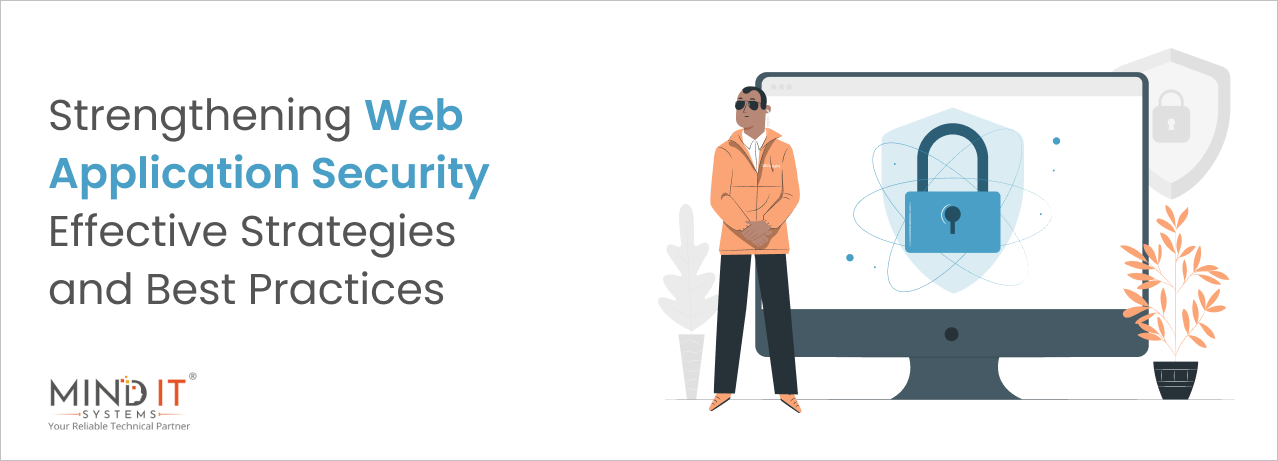
Strengthening Web Application Security: Effective Strategies and Best Practices
Introduction
Web application security is a global concern in today’s digital age. It’s a prime aspect for businesses and organizations worldwide. With the emergence of online platforms serving various functions, from e-commerce to communication, the stakes for safeguarding these web applications against potential vulnerabilities have never been higher. Web application and security are closely intertwined, as these platforms are the primary interface between users and the organization’s digital assets.
This blog aims to uncover and explore practical strategies and best practices for enhancing web application and security, which is more critical than ever.
So, here we go.
Let’s begin by understanding the importance of web application security.
Understanding the Importance of Web Application and Its Security
As the digital world continues evolving, the significance of ensuring robust web applications and security measures cannot be overstated. Web applications serve as the gateway for businesses to engage with customers, manage operations, and store sensitive data. However, these applications become vulnerable to myriad threats without adequate security measures, posing significant risks to the organization and its users.
Common Threats to Web Application Security
Web applications face various security threats, ranging from sophisticated cyber-attacks to automated exploits. These threats include, but are not limited to:
1. Injection attacks: Exploit input field vulnerabilities to execute malicious code.
2. Brute Force Attacks: Unauthorized access attempts by systematically guessing usernames and passwords.
3. Denial-of-Service (DoS) Attacks: Crush web application resources, making them inaccessible to legitimate users.
4. Data Breaches: Result from inadequate security measures, leading to unauthorized access and exposure of sensitive information.
5. Malware Infections: Compromise the integrity and functionality of the web application through malicious files or links.
Critical Strategies for Strengthening Web Application and Security
1. Robust Authentication Mechanisms
Implementing multi-factor authentication (MFA) and enforcing strong password policies are critical to enhancing web applications and security. Requiring users to examine their identity through multiple factors, such as passwords, biometrics, or tokens, reduces the risk of unauthorized access.
2. Utilizing Web Application Firewalls (WAF)
WAFs act as a defensive barrier between web applications and the Internet. By analyzing incoming traffic and filtering out malicious requests, WAFs mitigate common threats such as SQL injection and XSS attacks, bolstering the application’s security posture.
3. Regular Security Patching and Updates
Keeping web applications and underlying software up to date is critical for aiming at known vulnerabilities and reducing the risk of exploitation by cyber attackers. Regularly applying security patches and updates ensures the application can withstand emerging threats.
4. Implementing Secure Coding Practices
Adhering to secure coding practices during the development phase is fundamental for building resilient web applications. Techniques such as input validation, output encoding, and parametrized queries help prevent common vulnerabilities like injection attacks, fortifying the application against exploitation.
5. Conducting Regular Security Audits and Penetration Testing
Routine web application security audits and penetration testing are tactical measures to identify and address vulnerabilities in web applications. Organizations can uncover security weaknesses and implement corrective measures to mitigate potential risks by simulating real-world attack scenarios.
Dive deeper to stay tuned for practical guidance on mitigating web application threats and prioritizing security in your online operations.
The 4 Best Practices for Mitigating Web Application and Security Threats
Implementing best practices is crucial in mitigating potential threats and vulnerabilities regarding safeguarding web applications and security.
Here are some effective strategies to bolster your defenses:
Data Encryption and Secure Transmission Protocols:
Data encryption is essential in protecting sensitive information transmitted over the web. Organizations can avoid unauthorized access and ensure data confidentiality by encrypting data using robust encryption algorithms and utilizing secure transmission protocols, such as HTTPS. This safeguards user privacy and mitigates the risk of data breaches and cyber-attacks.
Implementing Access Controls and Role-Based Permissions
Controlling access to web applications is crucial for maintaining security and preventing unauthorized users from accessing sensitive data and features. Organizations can limit user privileges based on their roles and responsibilities by implementing access controls and role-based permissions. It helps reduce the risk of insider threats and unauthorized access, ensures that only authorized personnel can access critical web application resources, and maintains overall security.
Establishing Incident Response Plans
Despite best efforts to prevent security incidents, it’s essential to be prepared to respond effectively during a breach. Establishing incident response plans outlines predefined procedures for detecting, containing, and mitigating security incidents. It includes recognizing the root cause of the breach, restoring services, and implementing corrective measures to prevent future occurrences. Organizations can reduce the effect of security incidents and maintain business continuity by having a well-defined incident response plan.
Educating Users About Security Best Practices
User awareness and education are paramount in maintaining web application security. Informing users regarding security best practices, such as creating strong passwords, recognizing phishing attempts, and avoiding suspicious links, helps mitigate the risk of common security threats. By bringing up a culture of security awareness among users, organizations can reduce the likelihood of successful cyber-attacks and enhance overall security posture.
Ending Words
In conclusion, prioritizing web application and its security is imperative for safeguarding sensitive data, protecting against cyber threats, and maintaining users’ trust. Organizations can reinforce their defenses and mitigate the risk of security breaches by executing best practices such as data encryption, access controls, incident response plans, and user education.
In an age of continuously evolving cyber threats, investing in web application and maintaining security constantly is not only a proactive measure but also a critical aspect of ensuring the integrity and reliability of online operations.
Collaborate with a reputable web application development company to steer the digital landscape with confidence and resilience.
Share this post
About the Author

Sujoy Roy
(Head – Digital Marketing)
From my teenage time, I had a quench to solve problems and loved leadership. Starting my career in relation management, ignited my passion for managing people. While managing I realized technology needs to be incorporated to keep pace with the changing world & do my work efficiently.

